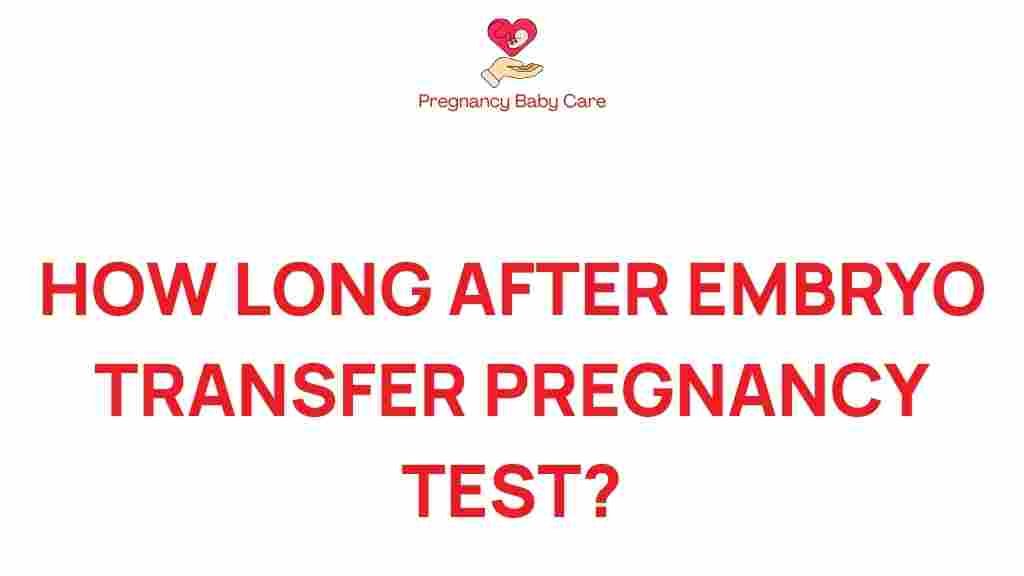The Countdown Begins: How Long to Wait for Your Pregnancy Test?
Embarking on the journey of in vitro fertilization (IVF) can be an exhilarating yet nerve-wracking experience. After the embryo transfer, one of the most pressing questions on your mind is: how long do you have to wait for your pregnancy test? Understanding the waiting period and what to expect during this time can help you manage your expectations and emotions. In this article, we will explore the timing of pregnancy tests following embryo transfer and its significance on your reproductive health.
Understanding the Waiting Period
The waiting period after an embryo transfer is often referred to as the “two-week wait” (TWW). This period is crucial as it allows your body to respond to the embryo transfer and, hopefully, achieve conception. Here’s a breakdown of what happens during this time:
- Embryo Transfer: During an IVF cycle, embryos are created in a lab and then transferred into the uterus.
- Implantation: After transfer, the embryo must implant itself into the uterine lining, which typically occurs 6-10 days post-transfer.
- Hormonal Changes: Once implantation is successful, your body begins producing the hormone hCG (human chorionic gonadotropin), which is what pregnancy tests measure.
It’s essential to allow enough time for these processes to occur before taking a pregnancy test, as testing too early can lead to inaccurate results.
Ideal Timing for Your Pregnancy Test
So, when is the best time to take a pregnancy test after embryo transfer? Generally, the optimal time to test is around 10-14 days post-transfer. Here’s a more detailed look:
- Day 5 Post-Transfer: While some tests may detect pregnancy as early as day 5, it is not recommended due to the risk of false negatives.
- Day 10 Post-Transfer: Testing at this point can offer more reliable results, but keep in mind that hCG levels may still be low.
- Day 14 Post-Transfer: This is usually the most accurate time to take a pregnancy test. By this time, if the embryo has implanted, your hCG levels should be high enough to produce a positive result.
Be sure to follow your fertility clinic’s guidelines regarding when to test, as they may have specific recommendations based on your unique situation.
Types of Pregnancy Tests
There are two primary types of pregnancy tests you can take:
- Home Pregnancy Tests: These are convenient and can be done in the privacy of your home. They detect hCG in your urine, but their accuracy depends on timing and user instructions.
- Blood Tests: Conducted at your fertility clinic, blood tests can provide quantitative results, measuring the exact levels of hCG in your blood. They are more sensitive than urine tests and can detect pregnancy earlier.
Tip: If you receive a positive result from a home test, follow up with your clinic for a blood test to confirm the pregnancy.
What to Expect During the Waiting Period
The waiting period can be emotionally challenging. Here are some tips to help you cope:
- Stay Informed: Read about others’ experiences but be cautious about overwhelming yourself with too much information.
- Practice Self-Care: Engage in relaxation techniques such as yoga, meditation, or light exercise to reduce anxiety.
- Seek Support: Connect with friends, family, or support groups who understand your journey.
Troubleshooting Common Concerns
During the waiting period, you may experience various symptoms or have concerns. Here are some common ones:
- Cramping: Mild cramping can be normal due to hormonal changes or the embryo implanting. However, severe pain should be discussed with your doctor.
- Spotting: Light spotting may occur and is often nothing to worry about. However, if the bleeding is heavy or accompanied by pain, contact your clinic.
- Emotional Ups and Downs: Hormonal fluctuations can cause mood swings. It’s essential to recognize these feelings as part of the process.
If you have any troubling symptoms or questions, don’t hesitate to reach out to your healthcare provider for reassurance.
Success Rates of IVF and Pregnancy Testing
Understanding the success rates of IVF can help set realistic expectations during your waiting period. Success rates can vary based on several factors:
- Age: Younger patients generally have higher success rates due to better egg quality.
- Embryo Quality: The quality of the embryos transferred can significantly impact the chances of conception.
- Health Factors: Overall reproductive health, including any underlying conditions, plays a crucial role.
Research shows that the cumulative success rates of IVF increase with multiple cycles. Therefore, if this cycle does not result in pregnancy, it’s important to remember that there are often more opportunities ahead. For more detailed information on IVF success rates, you can visit The Society for Assisted Reproductive Technology.
Conclusion
The countdown to your pregnancy test after an embryo transfer can feel like an eternity. However, understanding the timeline, testing options, and what to expect during this waiting period can help ease your mind. Remember that whether the test is positive or negative, you are not alone on this journey; support is available.
Stay positive and take care of yourself during this time, as your well-being is crucial to your reproductive health. For more insights and support on fertility and IVF, consider reaching out to professionals or joining community forums where you can share your experiences and learn from others.
Ultimately, the waiting period is just one part of your journey towards conception. Embrace it, and prepare for the next steps, whatever they may be.
This article is in the category Pregnancy and created by PregnancyBabyCare Team
